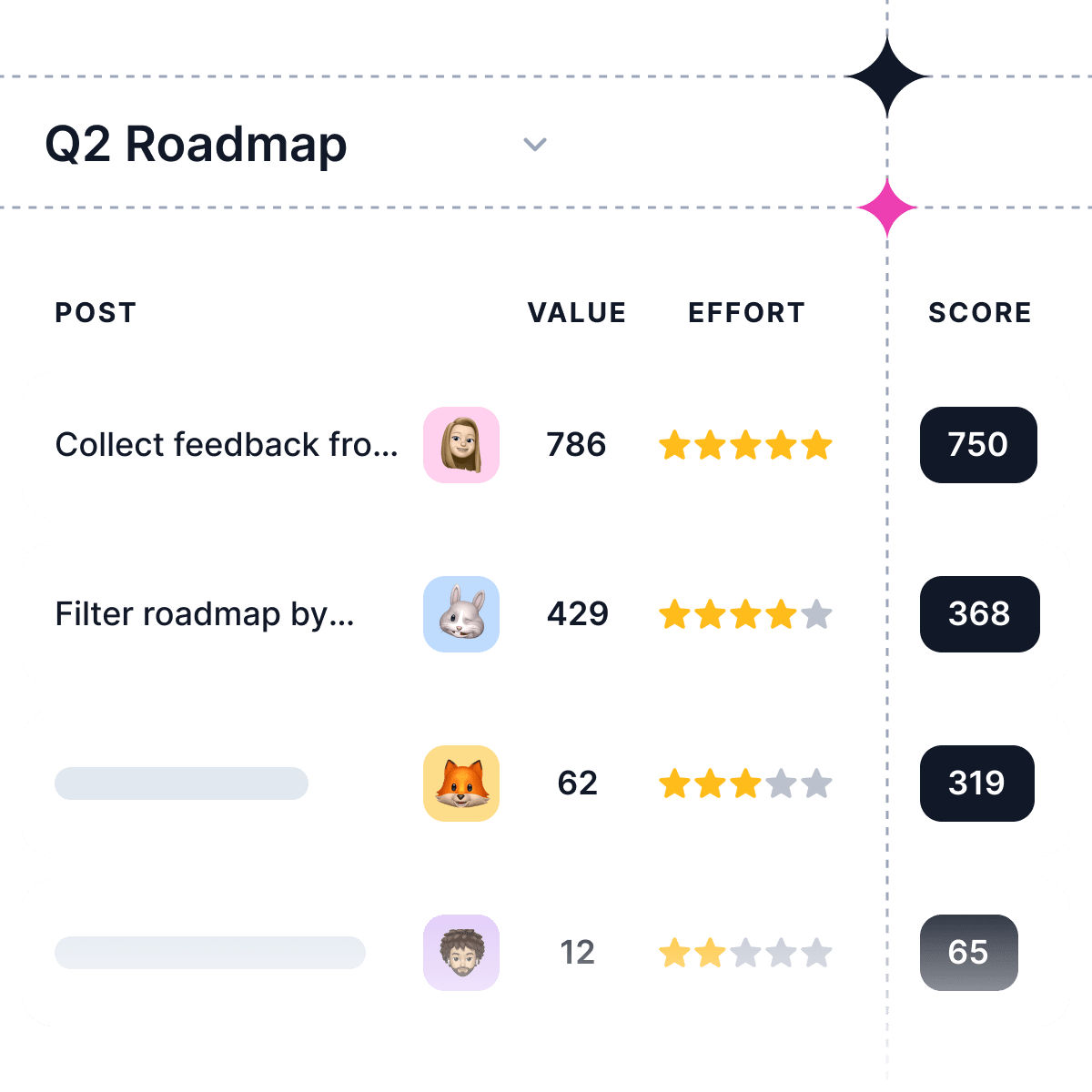As a product manager, creating a clear and effective product roadmap is crucial for aligning your team and stakeholders around your product strategy. A well-crafted roadmap communicates your product vision, goals, and timeline, ensuring everyone is on the same page. In this blog post, we'll explore some of the best product roadmap examples and different types of product roadmaps to help you create a roadmap that works for your team.
What is a Product Roadmap?
A product roadmap is a high-level visual summary that maps out the vision and direction of your product offering over time. It's a strategic guiding document as well as a plan for executing the product strategy. In 2024, as products and technologies continue to evolve at a rapid pace, having a clear and effective product roadmap is more important than ever.
Roadmaps enable product teams to clearly and effectively choreograph and articulate their product strategy. They provide a bird's-eye view of how the product will evolve, communicating current and future plans with stakeholders.
Essential Elements of Product Roadmaps
Regardless of the type of roadmap you choose, there are several key components that every effective product roadmap should include:
-
Product Vision and Strategy: Clearly articulate the long-term vision for your product and how it aligns with the overall business strategy.
-
Goals and Objectives: Define specific, measurable goals that the product aims to achieve, along with the metrics used to track progress.
-
Prioritized Initiatives: Identify and prioritize the key initiatives that will drive the product forward, based on their impact and alignment with the product vision.
-
Timelines and Milestones: Establish realistic timelines for each initiative and set clear milestones to mark significant achievements along the way.
-
Resource Allocation: Outline the resources (e.g., budget, personnel) required to execute each initiative and ensure that they are allocated effectively.
-
Stakeholder Alignment: Engage key stakeholders throughout the roadmapping process to ensure buy-in and alignment across the organization.
8 Product Roadmap Examples
1. Release Plan Roadmap
A release plan roadmap is a blueprint that documents and tracks the features planned for an upcoming product release cycle, usually spanning a quarter. This type of roadmap is ideal for communicating a high-level overview of upcoming releases to executives, stakeholders, cross-functional teams, and even customers.
Key elements of a release plan roadmap include:
-
Features or initiatives grouped by release
-
Estimated release dates or timeframes
-
Progress indicators for each feature
-
Connections to overarching goals or themes
Release plan roadmaps are useful for aligning teams around a shared schedule and keeping everyone informed about what's coming down the pipeline. They provide a realistic yet flexible view of your release plans.
2. Now-Next-Later Roadmap
A now-next-later roadmap organizes priorities into three-time horizons:
-
Now - What we're currently working on
-
Next - What's coming up soon
-
Later - Our longer-term plans
This type of roadmap is perfect for communicating your high-level product strategy and priorities to a wide audience. It focuses on outcomes rather than specific dates, making it adaptable to change.
Features in the "Now" column are well-defined, while those in "Next" and "Later" are more conceptual. As time goes on, items will shift from right to left as priorities evolve. Now-next-later roadmaps strike a great balance between providing a strategic outlook and remaining flexible.
3. Features Timeline Roadmap
A features timeline roadmap plots out upcoming features on a timeline, providing a Gantt chart view of your plans. This is a useful format for rallying teams around key dates and milestones.
Each swimlane represents a different release or theme, with individual feature cards placed along the timeline. Dependencies can be shown with arrows between cards.
Features timeline roadmaps are great for spotting bottlenecks, managing resources, and keeping everyone aligned on deadlines. They provide a granular view of what's happening when, making them indispensable for tactical planning.
4. Kanban Roadmap
A kanban roadmap uses the familiar structure of a kanban board to visualize the flow of work. Initiatives are grouped into columns based on their current status, such as:
-
Backlog
-
Planned
-
In Progress
-
Completed
Kanban roadmaps are ideal for conveying the current state of things without committing to hard dates. They're great for keeping development teams focused and stakeholders informed.
Cards in each column can be expanded to show more details like the assignee, due date, and associated goals. As work progresses, cards flow across the board, giving a real-time view of progress.
5. Objectives Timeline Roadmap
An objectives timeline roadmap focuses on the high-level goals and initiatives you're working towards. Rather than mapping out specific features, this type of roadmap shows the key objectives you aim to achieve in each time period.
Under each objective are the key results or deliverables that will contribute to meeting that objective. This format makes it easy to see how your plans ladder up to your strategic goals.
Objectives timeline roadmaps are ideal for getting executive buy-in and aligning teams around your product vision. They keep everyone focused on the "why" behind the work.
6. Portfolio Roadmap
For organizations managing multiple products or a complex product suite, a portfolio roadmap is essential. This type of roadmap provides a unified view of plans across your entire product portfolio.
The top row shows your overarching product themes or goals. Underneath, swimlanes represent each individual product, with bars indicating release timeframes. Milestones mark key dates or dependencies between products.
Portfolio roadmaps are invaluable for coordinating efforts across multiple teams and ensuring all your products are working in harmony towards common objectives. They provide a strategic overview for executives while still giving each product team autonomy over their own plans.
7. Sprint Plan Roadmap
For agile teams working in sprints, a sprint plan roadmap is a must-have. This type of roadmap outlines the features or stories planned for upcoming iterations.
Each column represents a sprint, with cards for the prioritized features or user stories to be tackled in that iteration. The backlog column holds unscheduled items that are ready to be slotted into an upcoming sprint.
Sprint plan roadmaps keep agile teams focused and aligned around short-term priorities while still providing visibility into future plans. They're a crucial communication tool for product owners and scrum masters.
8. Feature-based Roadmap
A feature-based roadmap focuses on the specific capabilities and functionalities that will be delivered in your product over time. Each row represents a feature or epic, with bars indicating the development timeframe. Color coding can be used to denote priority or status.
Feature-based roadmaps are ideal for communicating plans to technical teams and providing a granular view of what's coming down the pipeline. They help keep everyone aligned around the product's evolution and the work required to get there.
Choosing the Right Product Roadmap
With so many types of product roadmaps to choose from, how do you know which one is right for your team? The answer depends on several factors, including your audience, the level of detail required, and the nature of your product.
Here are some guidelines to help you select the most appropriate roadmap format:
-
Audience: Consider who will be viewing your roadmap and what information they need. Executives and stakeholders may prefer a high-level, goal-oriented roadmap, while development teams may require a more detailed, feature-based roadmap.
-
Level of Detail: Think about how granular your roadmap needs to be. A release plan roadmap provides a more detailed view than a now-next-later roadmap, for example. Choose a level of detail that balances providing enough information while maintaining flexibility.
-
Product Type: The nature of your product may influence the type of roadmap you choose. For example, a complex enterprise software product may benefit from a portfolio roadmap, while a mobile app may be better suited to a Kanban roadmap.
-
Team Methodology: Your team's development methodology may also impact your roadmap choice. Agile teams may prefer a sprint plan roadmap, while teams using a waterfall approach may opt for a features timeline roadmap.
Remember, your product roadmap is a communication tool. Choose a format that effectively conveys your plans and priorities to your intended audience.
Best Practices for Creating Product Roadmaps
To create a product roadmap that effectively guides your team and communicates your strategy, consider the following best practices:
-
Start with the "Why": Before diving into the details, clearly define the purpose and goals of your product roadmap. This will help you stay focused and ensure that every element of the roadmap aligns with the bigger picture.
-
Collaborate with Stakeholders: Involve key stakeholders, such as customers, sales teams, and executives, in the roadmapping process. Their insights and feedback will help you create a more comprehensive and realistic roadmap.
-
Prioritize Ruthlessly: Not every idea or feature can make it onto the roadmap. Use a prioritization framework, such as the RICE (Reach, Impact, Confidence, Effort) model, to objectively evaluate and rank initiatives based on their potential value and feasibility.
-
Keep it Visual: Use visual elements, such as timelines, color coding, and icons, to make your roadmap easy to understand at a glance. Avoid cluttering the roadmap with too much detail; instead, focus on the high-level initiatives and milestones.
-
Embrace Flexibility: Product roadmaps should be living documents that adapt to changing market conditions, customer needs, and business priorities. Regularly review and update your roadmap to ensure it remains relevant and accurate.
Putting it All Together
Creating an effective product roadmap requires a deep understanding of your product, your customers, and your business goals. By leveraging the right roadmap format and following best practices, you can craft a roadmap that serves as a powerful tool for alignment, communication, and execution.
As you embark on your roadmapping journey, remember that the process is just as important as the output. Engage your team and stakeholders throughout the process, gather feedback and insights, and iterate as needed. Your roadmap should be a living document that evolves alongside your product and your business.
The seven product roadmap examples we've explored - release plan, now-next-later, kanban, features timeline, objectives timeline, portfolio, and sprint plan - each have their own strengths and use cases. Choose the format that best fits your product, team, and audience.
When creating your roadmap, remember to start with the "why," collaborate with stakeholders, prioritize ruthlessly, keep it visual, and embrace flexibility. By following these best practices, you can create a roadmap that not only communicates your plans but also helps you navigate the ever-changing landscape of product development.
So go forth and roadmap! Embrace the power of this essential tool and use it to drive your product and your business forward. Happy roadmapping!






